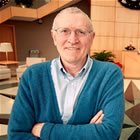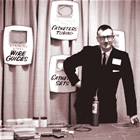|
Today the Cook Group consists of 42 companies employing more than 11,000 people at 15 manfacturing sites in the United States, Europe, Asia and Latin America.
At the time he started his tiny company, one of Bill Cook's first sales forays was to the Radiological Society of North America (RSNA) in Chicago, where he set up an exhibitor booth, showing wires, guides, catheter tubing and other small items used in diagnostic radiology procedures. He had purchased a Bunsen burner which he used to show how to form the catheters. A visitor to Cook's booth was a radiologist from Portland, Oregon, named Charles Dotter. Dotter had been working on his "crazy idea" of using catheters not just for diagnostic visualization of blocked arteries in the legs, but for treatment. By using progressively wider diameter catheters, Dotter thought he could open these blockages, without surgery. He called this technique "angioplasty".
Charles Dotter and Bill Cook hit it off and Cook began making catheters and wires to Dotter's specifications. Just two months after the RSNA, on January 16, 1964, Dr. Charles Dotter performed the first percutaneous transluminal angioplasty, opening up the blocked leg artery of a patient -- and the era of interventional medicine began, eventually revolutionizing the treatment of vascular blockages. Dotter was without question the "father" of angioplasty, and Bill Cook's new company was the first manufacturer in this new field. Both men got along because they were plain-talkers, hands on, part of a generation of innovators working out of garages, spare bedrooms and tool shops. To demonstrate his new technique, Dotter made a movie in 1965, a short clip of which can be seen here. He ends the film correctly predicting that his technique might find its way into the heart. A decade later it did! Dotter's ideas were scoffed at by many in the medical community who felt that vascular surgery was the best (and only) way to open up clogged arteries. Dotter became known as "Crazy Charlie", but he and Cook persevered and continued to improve upon the equipment.
At that time, angioplasty was not widely accepted in the United States, but a German radiologist, Eberhard Zeitler, started visiting Dotter and he brought the technique to Europe where, in 1974, a young Swiss German angiologist, named Andreas Gruentzig, attended Zeitler's seminar. Within a short time, Gruentzig had added a balloon to Dotter's catheter and performed the first coronary angioplasty. In 1980, Gruentzig honored Dotter at his final course in Zurich, before moving to the U.S. At Emory University in Atlanta, Gruentzig brought in a young Australian, Dr. Gary Roubin, who with Cesare Gianturco, went on to develop the first FDA-approved coronary stent, almost a year before the Palmaz-Schatz stent. The Gianturco-Roubin stent was manufactured by...Cook Medical! By the late 1980's, the new subspecialties of interventional radiology and cardiology had been launched. As stents and other catheter-based devices were developed, open surgery became utilized less and less and the era of medical devices flourished. And, as it did, other medical device companies appeared. In his 2008 book, "The Bill Cook Story: Ready, Fire, Aim!", biographer Bob Hammel delineates the story of inventions, mergers, affiliations and patent wars that punctuated the next two decades. Eventually Cook decided to cede the area of coronary intervention to others and concentrate on the peripheral applications of these technologies, developing the Zenith Stent Graft for the treatment of abdominal aortic aneurysms and the Zilver PTX paclitaxel-eluting peripheral stent, both of which have demonstrated great efficacy and durability. The Cook companies also expanded into urological equipment, OB/GYN devices, and endoscopic instruments, as well as real estate, travel, and aircraft services. Throughout this era of change, mergers and acquisitions, Cook Medical has remained a privately-held corporation. Founder Bill Cook passed away in April 2011. At that time global revenue for the company was approximately $2 billion annually. And, although Cook was listed in Forbes Wealthiest Americans, he and his wife Gayle continued to live modestly and to contribute to a number of historical preservation projects in Indiana, as well as sponsoring the Star of Indiana Drum and Bugle Corps, a traveling and performing group of young people. He even produced a Broadway musical, "Blast!" which won a Tony and an Emmy in 2001. His love of music extended to becoming the benefactor for the Cook Music Library, recognized as one of the largest academic music libraries in the world, at the Jacobs School of Music and Bloomington Campus of Indiana University. In addition, Cook companies have provided significant financial support to universities, hospitals and physicians throughout the country in order to aid the advancement of education and medical research. Happy Anniversary to Cook Medical! Reported by Burt Cohen, July 1, 2013 |


